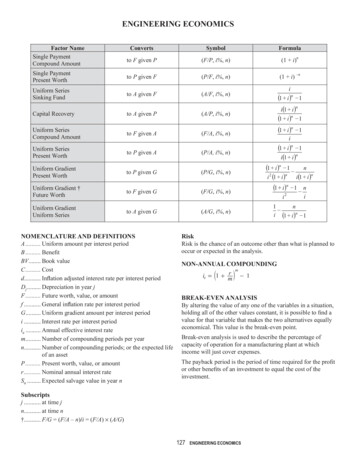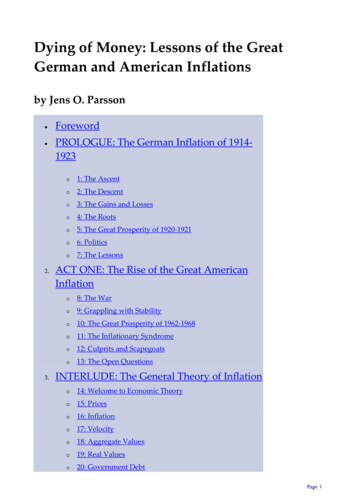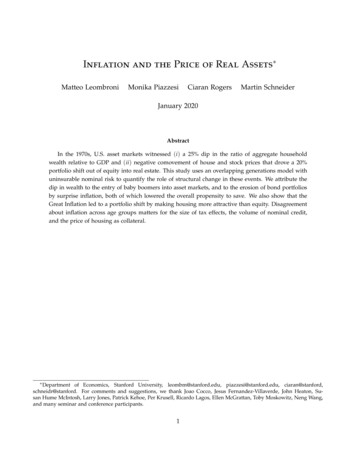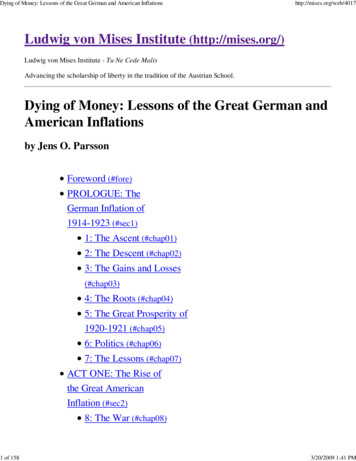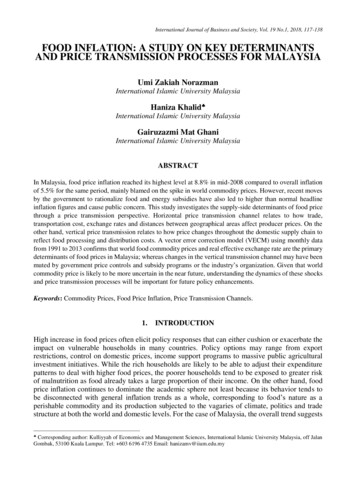
Transcription
International Journal of Business and Society, Vol. 19 No.1, 2018, 117-138FOOD INFLATION: A STUDY ON KEY DETERMINANTSAND PRICE TRANSMISSION PROCESSES FOR MALAYSIAUmi Zakiah NorazmanInternational Islamic University MalaysiaHaniza Khalid International Islamic University MalaysiaGairuzazmi Mat GhaniInternational Islamic University MalaysiaABSTRACTIn Malaysia, food price inflation reached its highest level at 8.8% in mid-2008 compared to overall inflationof 5.5% for the same period, mainly blamed on the spike in world commodity prices. However, recent movesby the government to rationalize food and energy subsidies have also led to higher than normal headlineinflation figures and cause public concern. This study investigates the supply-side determinants of food pricethrough a price transmission perspective. Horizontal price transmission channel relates to how trade,transportation cost, exchange rates and distances between geographical areas affect producer prices. On theother hand, vertical price transmission relates to how price changes throughout the domestic supply chain toreflect food processing and distribution costs. A vector error correction model (VECM) using monthly datafrom 1991 to 2013 confirms that world food commodity prices and real effective exchange rate are the primarydeterminants of food prices in Malaysia; whereas changes in the vertical transmission channel may have beenmuted by government price controls and subsidy programs or the industry’s organization. Given that worldcommodity price is likely to be more uncertain in the near future, understanding the dynamics of these shocksand price transmission processes will be important for future policy enhancements.Keywords: Commodity Prices, Food Price Inflation, Price Transmission Channels.1.INTRODUCTIONHigh increase in food prices often elicit policy responses that can either cushion or exacerbate theimpact on vulnerable households in many countries. Policy options may range from exportrestrictions, control on domestic prices, income support programs to massive public agriculturalinvestment initiatives. While the rich households are likely to be able to adjust their expenditurepatterns to deal with higher food prices, the poorer households tend to be exposed to greater riskof malnutrition as food already takes a large proportion of their income. On the other hand, foodprice inflation continues to dominate the academic sphere not least because its behavior tends tobe disconnected with general inflation trends as a whole, corresponding to food’s nature as aperishable commodity and its production subjected to the vagaries of climate, politics and tradestructure at both the world and domestic levels. For the case of Malaysia, the overall trend suggests Corresponding author: Kulliyyah of Economics and Management Sciences, International Islamic University Malaysia, off JalanGombak, 53100 Kuala Lumpur. Tel: 603 6196 4735 Email: hanizamv@iium.edu.my
118Food Inflation: A Study on Key Determinants and Price Transmission Processes for Malaysiathat food price inflation exhibit higher rate of volatility compared to general consumer prices(Figure 1).Literature on food prices often emphasized the effect of world agricultural commodity markets ondomestic prices of food products. However, Vavra and Goodwin (2005) argued that the world foodprice is more volatile than price of food production in domestic market and could have very littleinfluence on domestic retail prices. This is mostly true in the case of Malaysia (Figure 2). Theyexplained that changes in the global market are not always perfectly transmitted to the consumersdue to a number of factors such as trade and domestic agricultural price support policies. Inaddition, different levels of activity from production to consumption and vice versa would affectthe speed and size of the impact of a shock in prices at one level to another, either upstream ordownstream.Figure 1: Percentage Change of Monthly Malaysian Consumer Price Index and Malaysian 072011M042012M012012M102013M07Percentage Change (%)3-2MonthMCPIMFCPISource: Department of Statistics MalaysiaTheoretically, higher exchange rates contribute to higher costs of importing. What does this meanfor Malaysia as food items constitute a major part of the country’s import profile? The trend ofweak ringgit could inhibit imported inflation for Malaysia despite the exchange rate pass througheffects in the form of higher domestic prices especially for food items. To understand therelationship between exchange rates and food prices in Malaysia, we plotted both data in Figure 3.Granted, the development in the exchange rate of Malaysia trading partner and changes in inflationrates, have caused the real effective exchange rate of Malaysia to be unstable. Notably, in the year1998 the Ringgit depreciated as the Malaysian economy became affected by the Asian Financial
Umi Zakiah Norazman, Haniza Khalid and Gairuzazmi Mat Ghani119Figure 2: Indices of World Food Prices and Malaysian Food Price Production Index250.0Index alaysia food price index(MFPI)World Food Commodity Price Index (WFCPI)Source: Department of Statistics Malaysiacrisis, going as low as 84.71 points. After the crisis, it began to strengthen albeit slowly, increasingby more than 10 points after a year. In contrast, Malaysian food price index increased graduallyand reached the peak in the year 2013. This sets up the question whether changes in exchange ratesdo play a role in determining domestic food prices in 0Malaysia Consumer Price Index (MFCPI)Real Effective Exchange Rate (REER)Source: Department of Statistics MalaysiaIndex M062009M052010M042011M032012M022013M012013M12Index (points)Figure 3: World Commodity Food Price Index (WCPI) and Reel Effective Exchange Rate(REER)
120Food Inflation: A Study on Key Determinants and Price Transmission Processes for MalaysiaOn the domestic front, additional determinants of food price are those that affect cost of foodprocessing and retailing. Raw food imported from abroad such as milk, corn sugar and wheat areprocessed to produce final food products in many of Malaysian large and small-scale industries inMalaysia. High labor factor intensity in these industries inevitably affects food prices throughchanges in labor costs. Real labor cost of manufacturing sector increased consistently in the sampleperiod (Figure 4) except in 2008 where firms struggle to adjust production levels and labor costsespecially in the manufacturing sector (Nambiar, 2012). Again, the trend in no way shows anyresemblance to the domestic food price movements. Increase of labor cost tends to lead to theincreasing of food price while its reduction does not seem to have any effect.Figure 4: Real labor cost (in Ringgit Malaysia) and Malaysia Consumer Price Index (MCPI)30001000.02000100.01500100010.0Index (points)Ringgit Malaysia M092013M070Real Manufacturing Labor Cost (LCOST)Source: Department of Statistics MalaysiaAn equally important factor to be considered is world oil price. Agriculture as an energy-intensivesector makes it highly vulnerable to oil price shocks. On the other hand, for food processing firms,oil prices affects the costs of energy used for machines whilst for food retailing firms, it affectstheir costs of delivering the products to warehouses and retail outlet. In a nutshell, shocks in the oilmarket will give pressure to food prices at so many levels as the cost of importing, producing,processing and distributing food increase. Figure 5 below shows the relationship between worldoil price (Brent oil price) in dollar per barrel and the Malaysian Food Price Index. From the graph,it can be seen that in the long run, an oil price increase tends to increase the food price while theoil price reduction does not seem to affect food price, contributing to the ‘downward stickiness’theory of price.This study investigates the supply-side determinants of food price through a price transmissionperspective: horizontal and vertical. At the outset, horizontal price transmission process, i.e. fromthe world market to the domestic market appears to play a dominant role to influence the domesticof food price in Malaysia. It is because, for much of its food supply, Malaysia still needs to importfrom the other countries. Malaysia’s food import bill reached RM 15.4 billion mainly for sugar,
Umi Zakiah Norazman, Haniza Khalid and Gairuzazmi Mat Dollar per baller ( M052009M042010M032011M022012M012012M122013M11Index (points)Figure 5: Domestic Food Price Index and Brent Oil Price (dollar per barrel)Malysia Food Price Index (MFPI)OIL PRICE (Europe Brent Spot Price)Source: Department of Statistics Malaysiavegetables and fruits, and cocoa, dairy products and cereals for further processing for humanconsumption and animal feed production (MIDA, 2016). The vertical price transmission relates tohow price changes throughout the domestic supply chain. The vertical price transmission processis important to understand given the changing structural characteristics, given Malaysia’s shiftfrom a manufacturing-based economy to one that is service-based. This has implications on costsof food preparation, processing and should be studied in depth.Furthermore, this research aims to expand the pool of research available on this topic as far as amiddle-income country is concerned. In particular, the study aims to fill in the void in studies ondeterminants of food price inflation in Malaysia, where the main papers are Ibrahim (2015) andApplanaidu and Baharudin (2014). There is no study that we know of which investigates horizontaland vertical price transmission processes of food items. It is critical to have a strong understandingof the dynamic price shocks on the domestic retail price for policy formulation in agriculture, tradeand government transfers. Given recent events of food price surge in the market with high level offood price inflation in Malaysia, this study will determine which is the more critical pricetransmission channel and subsequently direct focus to the most effective solutions to food inflationissues.Food price inflation is a result of unique combination of micro and macro factors in the economy.It continues to be an important thread in development economics literature and has been studiedextensively. Our contribution to the relevant literature are threefold: the use of an expanded CVAR model to explain food prices per se, the horizontal and vertical price transmission analysisand finally a short and long run dynamic relationship analysis. The remaining text of the paper isorganized as follows. Section 2 describes the literature available, followed by a section outliningthe empirical technique and data. Section 4 discusses findings while Section 5 concludes.
122Food Inflation: A Study on Key Determinants and Price Transmission Processes for Malaysia2.LITERATURE REVIEWThe main focus of this chapter is to explore the literature on key determinants of domesticconsumer food price inflation. For traction, the literature review will be divided into two parts. Thefirst part will discuss the theoretical concept of horizontal and vertical price transmissions for food.The second part will highlight findings from previous studies to help guide the modeling of foodprice determinants specifically for Malaysia.2.1.Price Transmission ProcessesIn a general context, price transmission can be understood as a change of one good’s price thatcauses another good’s price to change. Cachia (2014) defines price transmission in the food sectoras “a percentage change in food consumer prices resulting from given changes in the internationalmarket price of a basket of agricultural commodities”. Listorti and Esposti (2012) defineshorizontal price transmission as price linkages from the raw commodity to producer levels. It canalso be perceived as linkages occurring among different markets at the same position along thesupply chain. The horizontal price transmission process is influenced by other factors such as thenumber of stages in marketing and the corresponding contractual arrangements between economicagents, storage and inventory holding, delays caused in transportation or processing, or “pricelevelling” practices (Davidson et al., 2011) as well as government’s subsidy and price controlpolicies. All these point to the role of the food industry’s degree of competition or governmentintervention in determining domestic food price behavior in response to global market shocks.Davidson et al. (2011) found that world commodity prices only indirectly affects UK food priceinflation in which the horizontal transmission process occurred through oil price effects. Bakucs etal. (2015) investigates the efficiency of European Union (EU) internal dairy market between 2000and 2014 through a systemic approach analysis. They found that, the horizontal price transmissionin milk sector in EU was less prominent than other sectors such as pork and cereals, mainly becauseof milk’s low trade costs and high trading volumes. Although physical trading is not a pre-requisitefor market integration in EU, its membership system significantly influences the integration ofprice across member countries. This underscores the importance of trade regime and trade activitiesin influencing horizontal price transmission within EU countries. The former concerns factors suchas trade cost, volumes, trade liberalization, exchange rates and distances between geographicalareas that may influence what happens between world’s agricultural commodity prices to producerprice at the domestic level, also known as farm gate prices (Davidson et. al., 2011, Listorti andEsposti, 2012; Bakucs et al., 2015; Areté Reasearch & Consulting in Economics, 2011; Asche etal., 2007).Vertical price transmission concerns price changes mainly from producer to wholesale and to retaillevel, reflecting food processing and distribution costs. Research on vertical price transmissioncaught on relatively late compared horizontal price transmission. Basically, the studies try tounderstand how uncertainties in the country’s local resource markets are eventually reflected indomestic food price formation. The scope of literature in vertical transmission studies often dealswith the following dimensions: (i) the magnitude of the response at each level given shock to otherlevel; (ii) the speed of the lag of adjustment of price to the equilibrium price in the market; and (iii)the nature of adjustment either following the positive or negative shock associated with asymmetricprice transmission and lastly the direction of adjustment of price transmission either upwards ordownwards in the supply chain (Vavra, & Goodwin, 2005).
Umi Zakiah Norazman, Haniza Khalid and Gairuzazmi Mat Ghani123Davidson et al. (2011) found that retail food price movement is accounted only in a small degreeby world raw commodity prices, the remaining is explained by changes in manufacturing costs offood. This finding is similar to Vavra and Goodwin’s (2005) in that raw agriculture commodityprices account for only around 20-30% of the final good price in the developed countries.Often the discussion about vertical price transmission also focuses on the issue of market poweralong the food supply chain. For instance, Lloyd et al. (2006) investigate the UK BovineSpongiform Encephalopathy (BSE) crisis using a Vector Error Correction Model (VECM), andfound that the high degree of market concentration in the UK beef market do influences relativechanges in retail and farm prices. The result also highlighted that the BSE crisis affect productionprices more than retail prices. More importantly, the presence of shocks to the retail demands andsupply will affect the retail farm margin. In contrast, the absence of shock will cause the risk onmargin losses to become minimum because the cost of production of food is solely determined bythe marketing cost throughout the supply chain.However, the nature and rate of adjustment may be affected by market distortions especially bygovernment intervention in the form of policies such as price support mechanism, agriculturepolicy instrument and so forth. Rajendran’s (2015) study for India found a large gap between thewholesale and retail prices especially in certain districts in India. Both positive and negativeasymmetries exist partly because of high risks of price loss due to weak-harvest infrastructure,imperfect price information and high transportations cost between the markets. Furthermore, thestudy detected the presence of market distortion due to high price mark-up and margins which latercreate price differences in India domestic retail market of onions. This goes to show the importanceof trading structure and scale in influencing local food distribution costs and subsequently foodprices. In our study, the variables that reflect the vertical price transmission process are labor costsand oil prices. While oil price has a role in both transmission channels, its effect in the horizontalprice transmission channel is believed to be subsumed in the movement of global commodityprices, hence our study investigates oil prices in the horizontal channel (Figure 6).Figure 6: Horizontal and Vertical Price Transmission Process for Food itemsPRODUCERPRICEHORIZONTALTRANSMISSIONTrade cost, volume,trade liberalizationtrade/ agriculture pricesupport policiesVERTICALTRANSMISSIONManufacturing andDistribution costsRETAILPRICESource: Author’s own
1242.2.Food Inflation: A Study on Key Determinants and Price Transmission Processes for MalaysiaEmpirical EvidencesThis subsection highlights findings from previous studies to help guide the variable selection andempirical approach for our study on food prices for Malaysia.(a)World food commodity pricesMost of the empirical literature found domestic retail food price to be positively related to worldfood commodity prices. Davidson et al. (2011), for instance, find that the world food commodityis one of the determinants of food price inflation in the case of UK. This finding is similar to thestudy done by Ferrucci et al. (2010) using a Vector Auto-Regression (VAR) estimation model ofdifferent food commodities and monthly data from January 1997 to June 2009. Local prices werethe result of dynamic reactions in the EU market to external and internal factors affecting worldcommodity prices such as bad weather condition, low inventories at the onset of the boom,imposition of trade in major food exporting countries as well as changes of consumption demandof the EU countries members. The impact of world commodity markets also applies to lessdeveloped countries. For instance, Rangasamy (2011) proves the increase of world commodityprice gives immediate positive impact to food price formation in South Africa.(b)Labor costIn general, retail prices are made of the price of raw commodities known as farm gate prices andits processing and marketing bills. The food processing bill involves to a large extent labor costssince the food industry remains mainly labor-intensive. As people consumed more processed andprepared food, the demand for inputs, especially labor, will increase and push up cost of production(Henderson and Executive, 2008; Irz et al., 2013). Often the study on the impact of labor costtowards inflation has been influenced by other dynamic macroeconomics factors. Landerretche etal. (2007) examined the price transmission effect of energy prices and inflation. In the presence ofoil price shocks, labor become more expensive in the economy as workers adjusts their inflationexpectations in the wake of shocks. The expectation margin falls and aggregate supply of goodsand services contracts. Consequently, labor cost is reverted to customer through price transmissionmechanism in terms of higher prices on finished food products. However, Davidson et al. (2011)found that labor cost is less significant to food price inflation rate in the UK, probably because inadvanced countries, food manufacturing is relatively less labor-intensive. In sum, labor cost as apotentially important supply shifter in the food price framework as long as food processing andretailing sectors remain labor-intensive and wage rates variable.(c)Real effective exchange rateExchange rate play dominant role in the price transmission of the world commodity prices todomestic market (Abbot et al., 2009; Landerretche et al., 2007; Nakamura and Zerom, 2010).Notably, world commodity prices and world oil price are the most important factors in the foodsupply. Any changes of these two factors are transmitted to domestic prices by what is called theexchange rate pass-through effect. As most of the commodities in the international market arepriced in US dollar, small changes in exchange rate may give significant impact to the othercountries (Abbot et al., 2009). Trostle (2008) explained that the depreciation of dollar has produceda positive impact on the international trade of food commodities as other countries are able toimport from the United States with lower prices. The depreciation of dollar also gives advantages
Umi Zakiah Norazman, Haniza Khalid and Gairuzazmi Mat Ghani125to the countries that have large foreign exchange reserves. Thus the appreciation of other currencyagainst the dollar will result to relative advantages of other countries to increase their food exportfrom the international market.Davidson et al. (2011) found that movement in the dollar exchange rate may offset or exacerbatethe effects of dollar denominated price of agricultural commodities in world market. Their studyfound that given 10% of shocks to dollar exchange rate, there is an immediate and largestquantitative impact to the market. This indicates that the food price inflation in UK is elastic to thechanges in the exchange rate. Similar findings are also found by Baek and Koo (2010). By applying(VECM) model, they found that exchange rate has a significant causal relationship at least in thelong run. In the case of Euro area, Ferrucci et al. (2010) concluded that a surge on aggregatedemand causes commodity prices to jump above the new long-run value in order to restore thesimultaneous equilibrium in the money and goods markets. As a result, although shock originatesin the retail sector, the commodity prices are the first to react because they are more flexible. Thus,the cost of exchange rate will be transferred to the commodity market first before be transmittedto the producer and consumer level. Previously, Abbott et al. (2009) show in the case of UnitedStates, depreciation of the exchange rate lead to higher prices in the United States, but a lower priceto the rest of world and vice versa. Essentially, movement in the dollar exchange rate may offsetor exacerbate the effects of dollar denominated price of agricultural commodities in world market(Davidson et al., 2011).For the case of Malaysia Applanaidu and Baharudin (2014) apply the VAR approach to studydynamic relationship of macroeconomics variables such as biodiesel production, exchange rates,government expenditure, Malaysia GDP and Malaysia’s policy towards food security in Malaysia.Exchange rate and government expenditure give highest shock to food security in year five whileGDP in year six indicating a high degree of domestic and global market integration via theexchange-rate effect.(d)World oil priceShock from oil prices may affect domestic food prices through various points in its supply chain:production, processing and distribution at both the global and local levels. Majority of the studiessupport the existence of an oil-price pass through effect in vertical and horizontal transmissionchannels (Nazlioglu and Soytas, 2012; Davidson et al., 2011; Blanchard and Gali, 2007). Oil priceaffects directly agriculture food prices in the short run and this later results in increase of energycost throughout the domestic food chain.In the case of Malaysia, a study by Ibrahim (2015) shows that in the long run, an oil price increasetend to increase food prices while the oil price reduction does not seem to affect food prices. Thestudy, which used a NRDL model and co-integrating vectors, noted that the degree of pricetransmission from oil price increase to the food price tends to be low with the changes onlysignificantly related in the short run. As Malaysia is one of the net oil-producing country in theworld, the adjustment of oil pass-through effect is very important to help policy-makers determinefood producer prices. The important highlights from the study is the presence of market power isthe most probable reason for fast upward adjustment of oil price into retail food price formation.The cross-country analysis by Jongwanich and Park (2011) found that Malaysia displays positivelevel of oil price through into domestic food price as a result of high intensity of oil use in total
126Food Inflation: A Study on Key Determinants and Price Transmission Processes for Malaysiaenergy consumption. Oil price shocks may not affect consumer prices depending on the firms’ability to pass higher cost into consumer prices in the presence of government intervention in theform of subsidies and price controls.3.METHOD AND DATAThe study attempts to build a structural model of food price inflation for Malaysia. Firstly, thestationarity properties for each of the variable included in the model is examined. The stationaryseries in I (1) are said to be co-integrated if there exists a linear combination of two time-serieswhich produces a stationary trend. If a set of series are co-integrated, there always exists agenerating mechanism called ‘error-correction mode’ which forces the variable to move closelytogether over time, while allowing for a wide range of short run dynamics (Engle and Granger,1987). The stationary times series also means that, the shock will be temporary and over time, theireffects will be eliminated to ensure the time series data revert to their long run values (Hendry &Juselius, 2001; Asteriou and Hall 2011).The maximum number of lags that need to be included in the model is determined through a lagselection model criteria test. The number of lags under consideration must be applied and thehypothesis for both tests specified. For this we employ Augmented Dickey Fuller (ADF) test andPhilip-Perron (PP) test as alternative to test the stationarity of the times series of the data (Dickey& Fuller, 1979; 1981).The procedure to test for non-stationarity of the data is necessary as the error term is unlikely to bewhite nose. The null hypothesis Ho: 1 (unity and hence ‘unit root’) and the alternativehypothesis H1: 1. The DF test statistics given by ADF test is the t-statistics for the laggeddependent variable. Hence, if the DF statistical value is smaller than the critical value then we canreject the null hypothesis and conclude that the variable does not has unit root or has stationaryprocess (Asteriou and Hall, 2011).The second test for unit root test is PP test. Phillip and Perron (1988) developed generalized ofADF test procedure. The PP test makes a correction to the t-statistics of the coefficient ᵞ from theAR (1) regression to account serial correlation in et. The same hypothesis goes to PP test with ADFtest. Hence, if the ADF-statistical value is smaller than the critical value then we can reject the nullhypothesis and conclude that the variable does not has unit root or has stationary process.To check the presence of structural breaks from changes in government policy on food pricesubsidies and controls for Malaysia, a multivariate Chow test is implemented (Chow, 1960; Fisher,1970). This test is preferable to the general Chow test because the study does not pre-determinethe specific points of structural breaks in the model due to lack of information on exact date ofgovernment policy changes. To ensure robustness of the test, the study also employs CUSUM testto verify the presence of structural breaks in the time series. The results give the number ofstructural breaks present and identify the remedies to this problem. A common solution is to dividethe time series into subsamples according to the structural breaks. Another alternative is to includedummy variables in the model. CUSUM test also are preferable because is said to have trivialpower (power of equal size) for local changes that specify at onetime change in the coefficientmodel (Perron, 2006). Next, co-integration test been applied in the model by apply two teststatistics that known as Trace and Maximal Eigenvalue statistics. As both of test are used to help
Umi Zakiah Norazman, Haniza Khalid and Gairuzazmi Mat Ghani127identify the number co integration of the model, as determined by Trace and the MaximalEigenvalue statistics ;λ𝑡𝑟𝑎𝑐𝑒 (𝑟) 𝑇 𝑘̂𝑖 𝑟 1 ln(1 λ𝑖 )λ𝑚𝑎𝑥 (𝑟,𝑟 1) 𝑇 𝑘̂𝑖 𝑟 1 ln(1 λ𝑟 1 )From the functions λ’s are estimated eigenvalues and where T is the number of effectiveobservations
Food Inflation: A Study on Key Determinants and Price Transmission Processes for Malaysia that food price inflation exhibit higher rate of volatility compared to general consumer prices (Figure 1). Literature on food prices often emphasized the effect of world agricultural commodity mark
